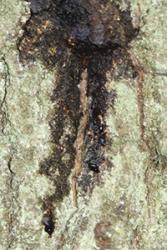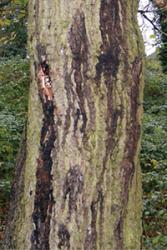Solving how a complex disease threatens our iconic oak
Latest scientific methods reveal multi-bacterial cause of stem bleeding in acute oak decline and pioneer novel methods for analysing the causes of complex plant diseases
Team work between Forest Research, Bangor University and others has for the first time, tracked down the cause of the stem bleeding symptoms of this newly identified threat to the native oak.
 Clear dark fluid seeping from cracks between bark plates on the stem of a mature oak with AODFrom 2008 onwards Forest Research, part of the Forestry Commission, were receiving increasing reports of a serious disease of native oak in many parts of the UK, particularly East Anglia, the Midlands, Welsh Borders and south east Wales. This complex disease, identified as acute oak decline (AOD), appears on the tree stem as patches of black fluid weeping from bark cracks, which cover over rotting tissue. In severe cases the stem rot can ring almost the entire girth of trees, preventing them from using water and nutrients essential for growth. The trees become weak and can die. The study, recently published in The ISME Journal (doi: 10.1038/ismej.2017.170), concludes that a mixture of different bacterial species cause the stem bleed in AOD. The authors explain that the complex nature of the disease makes identifying the cause of it challenging. A number of complementary scientific methods were used to discover the cause of the stem weeping and rot typical of the disease, providing a new means of identifying and studying complex plant diseases.
Clear dark fluid seeping from cracks between bark plates on the stem of a mature oak with AODFrom 2008 onwards Forest Research, part of the Forestry Commission, were receiving increasing reports of a serious disease of native oak in many parts of the UK, particularly East Anglia, the Midlands, Welsh Borders and south east Wales. This complex disease, identified as acute oak decline (AOD), appears on the tree stem as patches of black fluid weeping from bark cracks, which cover over rotting tissue. In severe cases the stem rot can ring almost the entire girth of trees, preventing them from using water and nutrients essential for growth. The trees become weak and can die. The study, recently published in The ISME Journal (doi: 10.1038/ismej.2017.170), concludes that a mixture of different bacterial species cause the stem bleed in AOD. The authors explain that the complex nature of the disease makes identifying the cause of it challenging. A number of complementary scientific methods were used to discover the cause of the stem weeping and rot typical of the disease, providing a new means of identifying and studying complex plant diseases.
Now that the causes of the stem weeping symptoms AOD have been established, scientists can work towards finding ways to halt the disease. This new means of identifying complex plant diseases can now also be used in other contexts.
Project director at Forest Research and lead author Dr Sandra Denman said:
“This is the first time that the cause of the stem rot of AOD has been shown in both field and laboratory tests with confirmation of the results at the molecular level. Although there is still more work to be done we have provided a scientific template for analysing the causes of complex diseases involving micro-organisms and insects. Without team work we could not have achieved our goals; we are now hopeful of developing ways to protect our oak trees”.
Dr James McDonald, Senior Lecturer and group leader for AOD research at Bangor University said:
“AOD is a major threat to Britain’s oak, and identifying the causes of stem rotting in this complex disease has been a challenging task. Using a combination of different scientific approaches has enabled us to get a better picture of the causes of stem bleeds in AOD and will hopefully enable a better understanding of other tree diseases that pose a risk to the global landscape.”
Dr James Doonan, a Post-Doctoral Researcher at the University’s School of Biological Sciences and joint-lead author on the paper said:
 External symptoms of AOD showing position of weeping patches on tree trunks.“DNA sequencing allows us to understand the nature of bacteria, whether they are harmless and innocent parties within the disease, or capable of destroying oak tissue. Using these new technologies, we took this a step further and actually recorded active destruction of tree tissue by analysing the activity of these bacteria in rotting tissue, complementing the isolation and infectivity tests by identifying the key bacterial agents.”
External symptoms of AOD showing position of weeping patches on tree trunks.“DNA sequencing allows us to understand the nature of bacteria, whether they are harmless and innocent parties within the disease, or capable of destroying oak tissue. Using these new technologies, we took this a step further and actually recorded active destruction of tree tissue by analysing the activity of these bacteria in rotting tissue, complementing the isolation and infectivity tests by identifying the key bacterial agents.”
The authors are grateful for support for this work from Woodland Heritage, the Rufford Foundation, the Monument Trust, the JPG fund, HPC Wales, the Forestry Commission and DEFRA (TH0108).
Publication date: 24 October 2017
